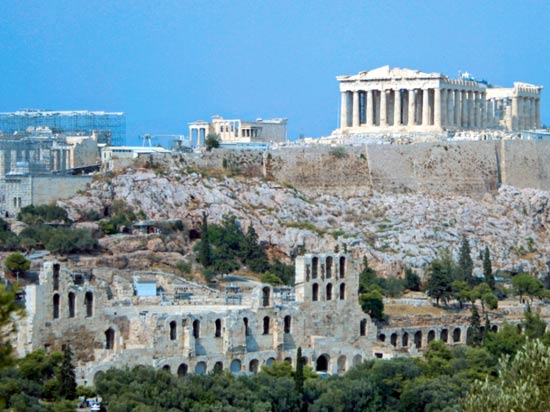Medieval Latin had ceased to be a living language and was
instead a scholarly language of the minority of educated men in medieval Europe
used in official documents more than for everyday communication. That resulted
in two major features of Medieval Latin compared with Classical Latin. First,
many authors attempted to "show off" their knowledge of Classical
Latin by using rare or archaic constructions, sometimes anachronistically
(haphazardly mixing constructions from Republican and Imperial Latin, which in
reality existed centuries apart). Second, many lesser scholars had a limited
grasp of "proper" Latin or were increasingly influenced by Vulgar
Latin, which was mutating into the Romance languages.
Word order usually tended towards that of the vernacular
language of the author, not the artificial and polished word order of Classical
Latin. Conversely, an erudite scholar might attempt to "show off" by
intentionally constructing a very complicated sentence. Because Latin is an
inflected language, it is technically possible to place related words at
opposite ends of a paragraph-long sentence, and owing to the complexity of
doing so, it was seen by some as a sign of great skill.
Typically, prepositions are used much more frequently (as in
modern Romance languages) for greater clarity, instead of using the ablative
case alone. Further, in Classical Latin the subject of a verb was often left
implied, unless it was being stressed: videt = "he sees". For
clarity, Medieval Latin more frequently includes an explicit subject: is videt
= "he sees" without necessarily stressing the subject.
Various changes occurred in vocabulary, and certain words
were mixed into different declensions or conjugations. Many new compound verbs
were formed. Some words retained their original structure but drastically
changed in meaning: animositas specifically means "wrath" in Medieval
Latin while in Classical Latin, it generally referred to "high spirits,
excited spirits" of any kind.
Owing to heavy use of biblical terms, there was a large influx
of new words borrowed from Greek and Hebrew and even some grammatical
influences. That obviously largely occurred among priests and scholars, not the
laity. In general, it is difficult to express abstract concepts in Latin, as
many scholars admitted. For example, Plato's abstract concept of "the
Truth" had to be expressed in Latin as "what is always true".
Medieval scholars and theologians, translating both the Bible and Greek
philosophers into Latin out of the Koine and Classical Greek, cobbled together
many new abstract concept words in Latin.
Many striking differences between classical and medieval
Latin are found in orthography. Perhaps the most striking difference is that
medieval manuscripts used a wide range of abbreviations by means of superscripts,
special characters etc.: for instance the letters "n" and
"s" were often omitted and replaced by a diacritical mark above the
preceding or following letter. Apart from this, some of the most frequently
occurring differences are as follows. Clearly many of these would have been
influenced by the spelling, and indeed pronunciation, of the vernacular
language, and thus varied between different European countries.
Following the Carolingian reforms of the 9th century,
Carolingian minuscule was widely adopted, leading to a clear differentiation
between capital and lowercase letters.
A partial or full differentiation between v and u, and
between j and i.
The diphthong ae is usually collapsed and simply written as
e (or e caudata, ę); for example, puellae might be written puelle (or puellę).
The same happens with the diphthong oe, for example in pena, Edipus, from
poena, Oedipus. This feature is already found on coin inscriptions of the 4th
century (e.g. reipublice for reipublicae). Conversely, an original e in
Classical Latin was often represented by ae or oe (e.g. aecclesia and coena),
also reflected in English spellings such as foetus.
Because of a severe decline in the knowledge of Greek, in
loanwords and foreign names from or transmitted through Greek, y and i might be
used more or less interchangeably: Ysidorus, Egiptus, from Isidorus, Aegyptus.
This is also found in pure Latin words: ocius ("more swiftly")
appears as ocyus and silva as sylva, this last being a form which survived into
the 18th century and so became embedded in modern botanical Latin (also cf.
Pennsylvania).
h might be lost, so that habere becomes abere, or mihi
becomes mi (the latter also occurred in Classical Latin); or mihi may be
written michi, indicating that the h had come to be pronounced as k or perhaps
kh. This pronunciation is not found in Classical Latin.
The loss of h in pronunciation also led to the addition of h
in writing where it did not previously belong, especially in the vicinity of r,
such as chorona for corona, a tendency also sometimes seen in Classical Latin.
-ti- before a vowel is often written as -ci- [tsi], so that
divitiae becomes diviciae (or divicie), tertius becomes tercius, vitium vicium.
The combination mn might have another plosive inserted, so
that alumnus becomes alumpnus, somnus sompnus.
Single consonants were often doubled, or vice versa, so that
tranquillitas becomes tranquilitas and Africa becomes Affrica.
Syncopation became more frequent: vi, especially in verbs in
the perfect tense, might be lost, so that novisse becomes nosse (this occurred
in Classical Latin as well but was much more frequent in medieval Latin).
These orthographical differences were often due to changes
in pronunciation or, as in the previous example, morphology, which authors reflected
in their writing. By the 16th century, Erasmus complained that speakers from
different countries were unable to understand each other's form of Latin.[3]
The gradual changes in Latin did not escape the notice of
contemporaries. Petrarch, writing in the 14th century, complained about this
linguistic "decline", which helped fuel his general dissatisfaction
with his own era.




